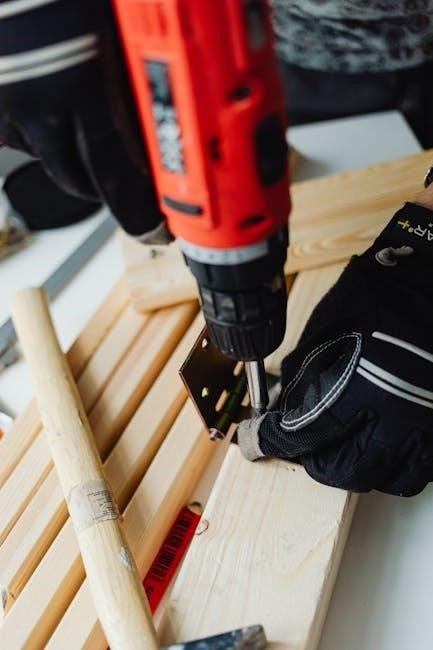
The Honeywell TH5220D1003 is a user-friendly programmable thermostat designed for compatibility with various HVAC systems. It offers precise temperature control‚ energy efficiency‚ and easy installation. This guide provides detailed instructions for installing and configuring the thermostat‚ ensuring optimal performance and comfort.
Overview of the Honeywell TH5220D1003
The Honeywell TH5220D1003 is a programmable thermostat designed for compatibility with a wide range of HVAC systems‚ including heat pumps and conventional heating/cooling systems. It features a touchscreen interface for easy navigation and programming. This thermostat supports up to 3 stages of heat and 2 stages of cool‚ making it versatile for various home setups. Its energy-efficient design helps reduce utility bills‚ while its intuitive controls ensure seamless operation. The TH5220D1003 is ideal for homeowners seeking precise temperature control and flexibility in managing their comfort settings throughout the day.
Importance of the Installation Manual
The installation manual for the Honeywell TH5220D1003 is essential for ensuring a smooth and correct setup. It provides step-by-step instructions‚ wiring diagrams‚ and safety precautions to guide installers through the process. Proper installation is crucial for optimal performance‚ energy efficiency‚ and system longevity. The manual also highlights compatibility with HVAC systems and electrical requirements‚ helping users avoid common pitfalls; By following the manual‚ installers can ensure the thermostat functions as intended‚ providing precise temperature control and enhancing home comfort. Adherence to the manual’s guidelines is key to maximizing the thermostat’s capabilities and maintaining warranty validity.

System Requirements and Compatibility
The Honeywell TH5220D1003 is compatible with most 24V AC HVAC systems‚ including heat pumps and conventional heating/cooling units. It requires a 24V AC power supply and supports multi-stage systems. Proper installation ensures seamless integration with existing setups‚ providing reliable temperature control and energy efficiency.
Compatibility with HVAC Systems
The Honeywell TH5220D1003 thermostat is designed to work with a wide range of HVAC systems‚ including heat pumps‚ gas furnaces‚ and air conditioning units. It supports both single-stage and multi-stage systems‚ ensuring flexibility for various home configurations. The thermostat is compatible with 24V AC systems and can handle multiple wiring configurations. Proper installation requires verifying system specifications to ensure seamless integration. Compatibility with heat pumps‚ including auxiliary heat‚ enhances its versatility. Always check the system requirements before installation to ensure optimal performance and avoid potential issues.
Electrical Requirements
The Honeywell TH5220D1003 thermostat requires a 24V AC power supply‚ ensuring compatibility with most standard HVAC systems. Proper wiring is essential‚ and the thermostat must be connected to the correct terminals to function correctly. It is critical to follow the wiring diagram provided in the manual to avoid electrical issues. The ‘L’ terminal should be connected to a continuous power source‚ while the ‘R’ terminal connects to the heating and cooling systems. Ensure all connections are secure and meet local electrical codes. Improper wiring can lead to system malfunctions or safety hazards. Always turn off the power before starting installation to prevent electrical shock. Adhering to these requirements ensures safe and efficient operation of the thermostat.
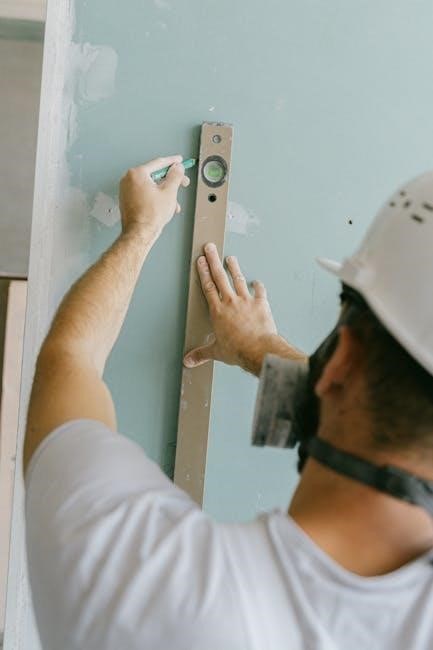
Pre-Installation Steps
Before installing the Honeywell TH5220D1003‚ ensure the site is prepared‚ tools and materials are gathered‚ and safety precautions are understood. Plan the installation carefully‚ verify system compatibility‚ and review the manual to avoid errors during the process.
Preparing the Site
Before starting the installation‚ turn off the power to the HVAC system at the circuit breaker or fuse box. Clean the area around the old thermostat to ensure a smooth replacement. Locate the wall studs to secure the wall plate properly. Remove the existing thermostat and inspect for any damage or marks. Cover the surrounding area with a drop cloth to protect it from debris. Ensure all wires are safely capped and labeled for easy identification. Verify the system is cool or off to avoid any accidental activation during installation.
Tools and Materials Needed
To install the Honeywell TH5220D1003 thermostat‚ gather the following tools and materials: a screwdriver (Phillips and flathead)‚ wire strippers‚ a voltage tester‚ a drill with bits‚ wall anchors‚ a level‚ and a pencil. Ensure the wall plate is included in the packaging; Verify the presence of the thermostat unit‚ batteries‚ and installation manual. Use a voltage tester to confirm the system is de-energized before starting. Having all tools and materials ready ensures a smooth and efficient installation process. Double-check the packaging for any additional components provided with the thermostat.
Safety Precautions
Before installing the Honeywell TH5220D1003 thermostat‚ ensure the HVAC system is powered off at the circuit breaker or fuse box. Verify the power is off using a voltage tester to avoid electrical shock. Avoid touching live wires or components. Wear protective gear‚ such as gloves and safety glasses‚ when handling tools or drilling. Keep the work area clear of debris and flammable materials. Follow all local electrical codes and manufacturer guidelines. If unsure‚ consult a licensed electrician. Turn off power before starting any installation or wiring tasks to ensure a safe working environment. Proper precautions prevent accidents and ensure a successful installation.
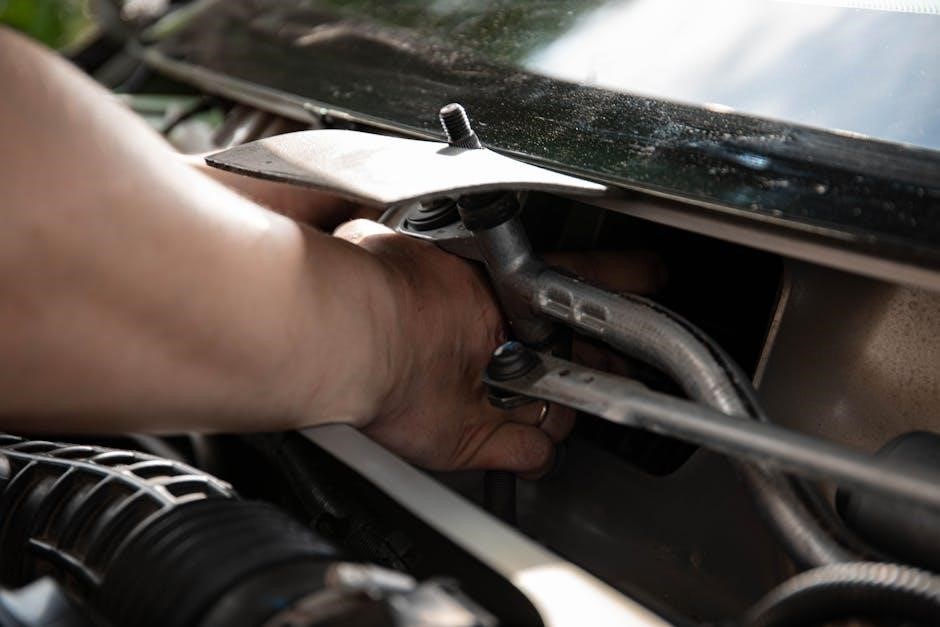
Installation Process
The Honeywell TH5220D1003 thermostat installation involves mounting the wall plate‚ connecting wires‚ and attaching the thermostat. Follow the manual for step-by-step guidance to ensure proper setup and functionality.
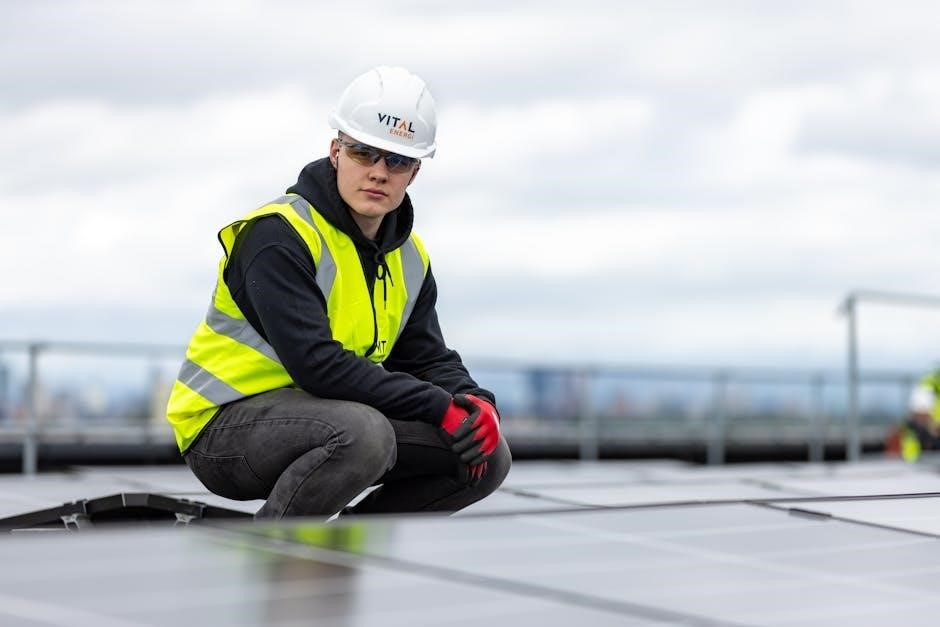
Mounting the Wall Plate
Mounting the wall plate is the first step in installing the Honeywell TH5220D1003 thermostat. Begin by turning off the power to your HVAC system at the circuit breaker. Remove the old thermostat and take note of the wires. Use the provided wall anchors to secure the wall plate to the wall‚ ensuring it is level. Align the plate with the mounting screws or existing holes from the previous thermostat. Gently tighten the screws to hold the plate in place. If necessary‚ use the included adhesive-backed wall anchors for drywall or plaster walls. This ensures a sturdy and even installation surface for the thermostat.
Connecting the Wires
Connecting the wires is a critical step in the installation process. Start by turning off the power to your HVAC system at the circuit breaker. Remove the old thermostat and label the wires according to their functions (e.g.‚ R‚ W‚ Y‚ G‚ C). Refer to the wiring diagram in the manual to ensure proper connections. Attach each wire to the corresponding terminal on the wall plate‚ securing them firmly. Double-check the connections to avoid loose wires‚ which could cause malfunctions. If your system requires a common wire (C)‚ ensure it is connected to the C terminal. Avoid over-tightening‚ as this may damage the terminals. Once all wires are securely connected‚ proceed to the next step.
Installing the Thermostat
Once the wall plate is mounted and wires are connected‚ carefully align the thermostat with the wall plate‚ ensuring it fits securely. Gently push the thermostat onto the plate until it clicks into place. Verify that the thermostat is level and properly seated. Secure it with the provided screws if necessary. After installation‚ turn the power back on at the circuit breaker and test the thermostat by adjusting the temperature settings. Ensure all functions operate correctly‚ such as heating‚ cooling‚ and fan modes. If any issues arise‚ refer to the troubleshooting section of the manual for guidance.
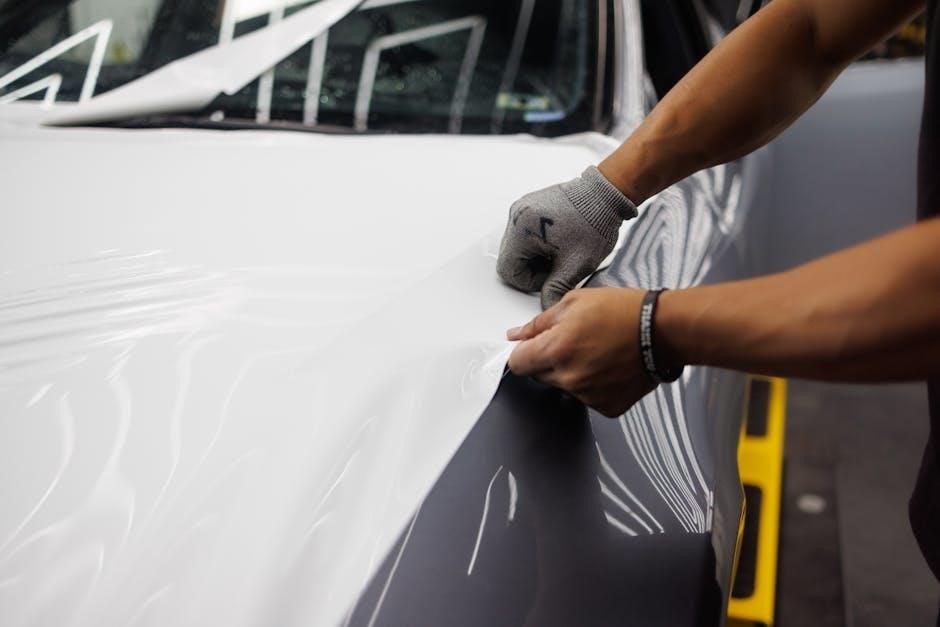
Configuration and Setup
After installation‚ configure the thermostat by setting installer options and basic preferences. Navigate through the menu to customize temperature ranges‚ heating/cooling modes‚ and system settings for optimal performance.
Setting Up Installer Options
During setup‚ access the installer menu to configure system-specific settings. Adjust parameters like heat pump type‚ staging options‚ and changeover modes; Ensure settings match your HVAC system for proper operation. Set Function 12 to “Manual” or “Auto” based on your system’s requirements. Refer to the manual for detailed instructions on each option. Proper configuration ensures compatibility and optimal performance. This step is crucial for aligning the thermostat with your system’s capabilities‚ preventing issues and ensuring reliable operation.
Configuring Basic Thermostat Settings
Configure basic settings like temperature range‚ heating/cooling modes‚ and fan operation. Set the desired temperature and choose between Heat‚ Cool‚ or Auto modes. Adjust the temperature range to suit your comfort preferences. Use the touchscreen interface to navigate through settings and ensure proper system operation. These configurations ensure the thermostat operates efficiently and maintains consistent temperatures. Proper setup is essential for optimal performance and energy savings. Refer to the manual for step-by-step guidance on configuring these settings accurately.
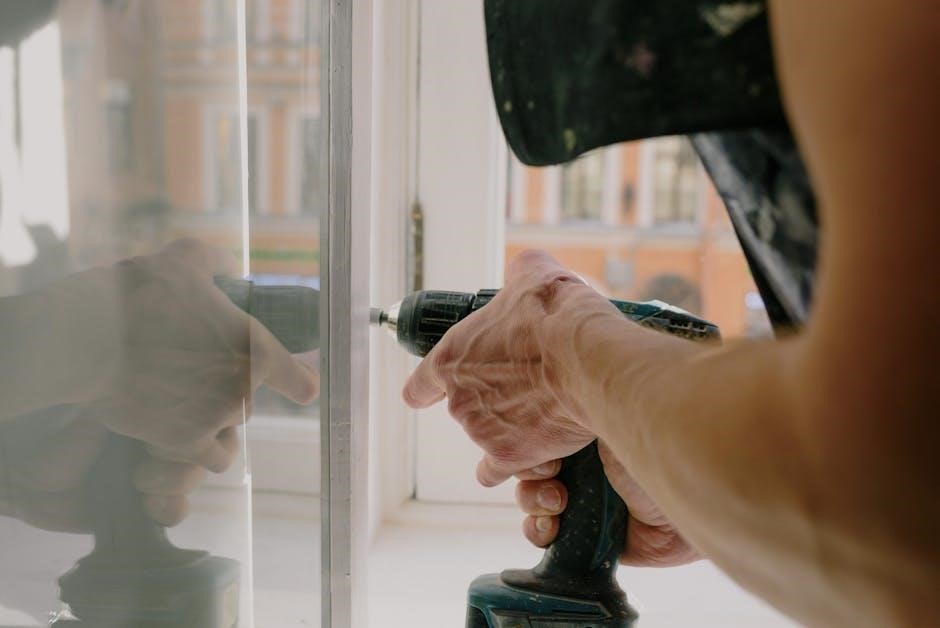
Programming the Thermostat
Programming the Honeywell TH5220D1003 allows creating a weekly schedule and setting temperature preferences‚ enhancing energy efficiency and comfort. Follow the manual for detailed steps.
Creating a Weekly Schedule
Creating a weekly schedule on the Honeywell TH5220D1003 involves defining temperature settings for each day of the week. Users can set specific temperatures for different time periods‚ such as wake‚ leave‚ return‚ and sleep. This feature allows for energy efficiency by adjusting temperatures when the home is unoccupied. The thermostat also supports setting the same schedule for multiple days‚ simplifying the process. After configuring‚ save the schedule to ensure it runs automatically; This feature helps maintain a consistent comfort level while optimizing energy usage throughout the week.
Setting Temperature Preferences
Setting temperature preferences on the Honeywell TH5220D1003 allows users to customize heating and cooling levels for optimal comfort. The thermostat enables setting preferences for different times of the day‚ such as when the home is occupied or unoccupied. Users can also adjust temperature ranges for heating and cooling modes to suit their needs. The thermostat adapts to the system type‚ ensuring accurate temperature control. This feature promotes energy efficiency while maintaining a comfortable environment‚ making it easy to balance convenience and savings throughout the day.
Advanced Programming Features
The Honeywell TH5220D1003 offers advanced programming features for tailored heating and cooling control. Users can set up custom schedules and adjust settings based on specific system types‚ such as heat pumps. The thermostat supports features like automatic changeover and smart recovery‚ optimizing performance. Installer settings allow for fine-tuning‚ ensuring compatibility with various HVAC systems. Advanced features enable precise temperature control‚ energy savings‚ and adaptability to user preferences‚ making it ideal for modern home comfort needs while maintaining efficiency and ease of use.

Troubleshooting Common Issues
Identify issues by checking error codes and verifying wiring connections. Ensure proper installation and system compatibility. Restart the thermostat and HVAC system to resolve common operational problems.
Identifying Common Problems
Common issues with the Honeywell TH5220D1003 include incorrect wiring connections‚ display malfunctions‚ and system compatibility problems. Error codes like “E1” or “E2” may indicate sensor or wiring faults. Additionally‚ the thermostat may fail to power on if the HVAC system is not properly connected. Users should also check for loose wire connections or damaged terminals‚ which can disrupt communication between components. Ensuring the thermostat is compatible with the HVAC system is crucial to avoid operational issues. Always refer to the installation manual for troubleshooting specific error codes and solutions.
Resolving Wiring Issues
Wiring issues can often be resolved by verifying connections and ensuring compatibility. Check for loose wires or incorrect terminal assignments‚ as these can cause malfunctions. Refer to the installation manual for proper wiring configurations. If the system fails to power on‚ ensure the HVAC system is correctly connected. For models with specific requirements like two-stage heating or cooling‚ confirm the wiring matches the system type. Always turn off power before troubleshooting. If issues persist‚ consult the manual or contact Honeywell support for assistance. Correct wiring ensures reliable performance and prevents error codes related to system communication.
Understanding Error Codes
Error codes on the Honeywell TH5220D1003 indicate specific issues‚ such as wiring problems or system incompatibilities. Refer to the installation manual to decode these codes‚ as they provide guidance for troubleshooting. Common errors include incorrect wiring connections or sensor malfunctions. For example‚ an “E1” error often relates to temperature sensor issues‚ while “E30” may indicate a communication failure. Addressing these codes involves checking wiring‚ ensuring proper system compatibility‚ and restarting the thermostat if necessary. Regularly reviewing the manual ensures accurate diagnoses and resolutions‚ preventing prolonged system downtime and maintaining optimal performance.
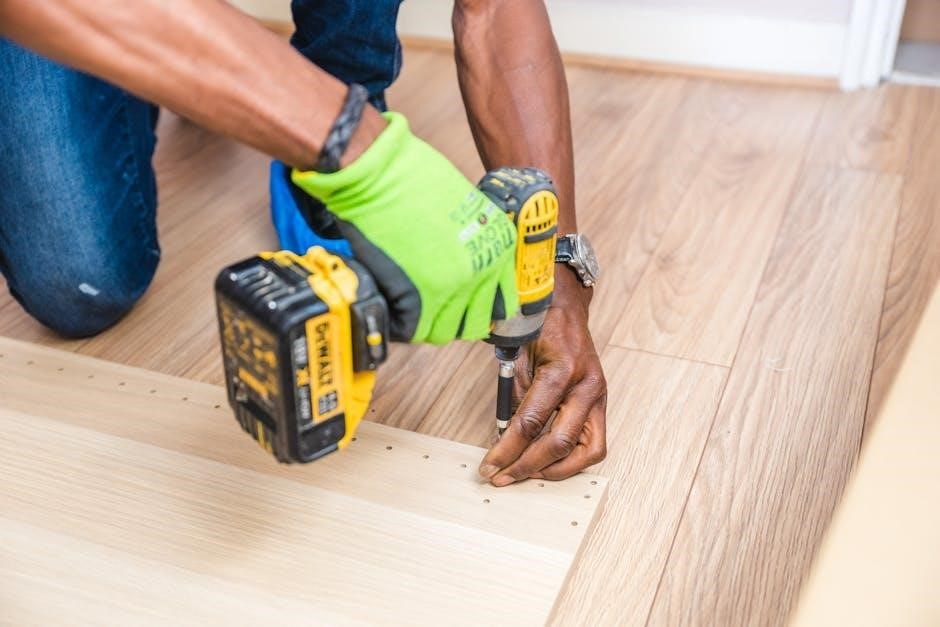
Maintenance and Care
Regular maintenance ensures optimal performance of the Honeywell TH5220D1003 thermostat. Clean the display and sensors with a soft cloth‚ replace batteries annually‚ and update software if applicable.
- Clean the thermostat regularly to avoid dust buildup.
- Replace batteries as indicated by low-battery warnings.
- Check for software updates to ensure latest features.
Cleaning the Thermostat
Cleaning the Honeywell TH5220D1003 is essential for maintaining functionality and accuracy. Use a soft‚ dry cloth to gently wipe the display and exterior surfaces. Avoid harsh chemicals or liquids‚ as they may damage the thermostat. For stubborn dust or debris‚ lightly dampen the cloth with water‚ but ensure no moisture enters the device. Regular cleaning prevents dust buildup and ensures precise temperature readings; This simple maintenance step helps extend the lifespan of your thermostat and maintains optimal performance throughout the year.
Replacing Batteries
To ensure uninterrupted operation‚ replace the Honeywell TH5220D1003 thermostat batteries as needed. Use two fresh AA alkaline batteries. Locate the battery compartment on the rear of the thermostat. Open it by sliding it downward or following the indicated instructions. Remove the old batteries and insert the new ones‚ matching the polarity signs. Close the compartment securely. Proper battery replacement prevents system malfunctions and maintains precise temperature control. Dispose of used batteries responsibly‚ following local guidelines. This simple step ensures your thermostat continues to operate efficiently and reliably year-round.
Updating Software (if applicable)
The Honeywell TH5220D1003 thermostat does not require software updates‚ as it operates without Wi-Fi connectivity. However‚ if firmware updates are ever released‚ ensure your thermostat is updated to maintain optimal performance. To check for updates‚ refer to the installation manual or visit Honeywell’s official website. Follow the provided instructions carefully to avoid system disruptions. Always use genuine Honeywell updates to ensure compatibility and security. If unsure‚ contact Honeywell support for assistance. Keeping your thermostat updated guarantees access to the latest features and improvements.
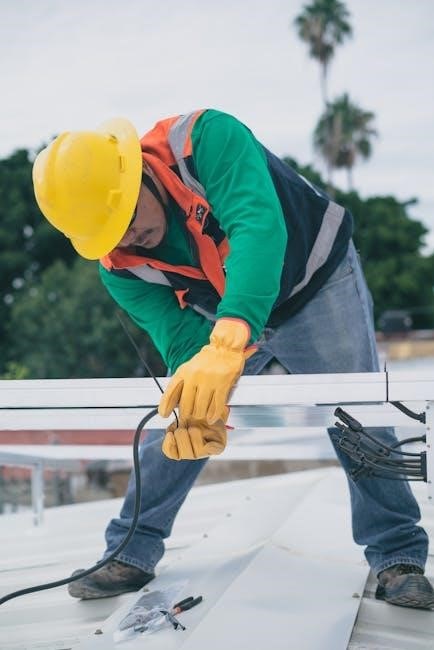
Additional Resources
Visit Honeywell’s official website for the TH5220D1003 manual‚ troubleshooting guides‚ and FAQs. Explore online forums and video tutorials for additional support and installation tips.
Manufacturer Support and Contact Information
Honeywell provides comprehensive support for the TH5220D1003 thermostat. Visit their official website at Honeywell.com to download the installation manual‚ troubleshooting guides‚ and FAQs. For direct assistance‚ contact Honeywell Customer Support at 1-800-328-6326 or via email through their website. International customers can find region-specific contact details on the Honeywell website. Additionally‚ Honeywell offers a warranty program and dedicated technical support to ensure optimal performance of your thermostat. Reach out to their team for any queries or concerns regarding installation‚ configuration‚ or maintenance.
Online Communities and Forums
For additional support and insights‚ visit online communities and forums dedicated to Honeywell thermostats. Websites like Reddit’s Home Automation community and HVAC-Talk offer valuable discussions and tips from experienced users and professionals. These platforms are ideal for troubleshooting‚ sharing installation experiences‚ and learning about advanced features; Honeywell also hosts its own support forum‚ where you can engage with experts and find solutions to common issues. Join these communities to enhance your understanding and maximize the performance of your Honeywell TH5220D1003 thermostat.
Video Tutorials and Guides
Video tutorials are an excellent resource for understanding the installation and operation of the Honeywell TH5220D1003 thermostat. Platforms like YouTube offer step-by-step guides and troubleshooting tips. Search for “Honeywell TH5220D1003 installation tutorial” or “Honeywell thermostat programming guide” to find relevant content. Additionally‚ Honeywell’s official YouTube channel provides professional tutorials and installation videos. These resources are ideal for visual learners and those seeking hands-on guidance to ensure a smooth setup and optimal performance of their thermostat.
With the Honeywell TH5220D1003 installation manual‚ you’ve successfully installed and configured your thermostat for optimal performance. This guide provided comprehensive support for a seamless setup experience.
Final Checklist for Successful Installation
Ensure all wires are securely connected according to the wiring diagram.
Verify the wall plate is properly mounted and level.
Test the thermostat by running a heating and cooling cycle.
Set the correct system type in the installer settings.
Program your preferred temperature schedule.
Check for any error codes and resolve them.
Dispose of packaging materials responsibly.
Store the manual for future reference.
Best Practices for Optimal Performance
Regularly clean the thermostat to ensure accurate temperature readings.
Update the software periodically to access new features and improvements.
Set realistic temperature ranges to balance comfort and energy efficiency.
Schedule periodic maintenance checks for your HVAC system.
Ensure batteries are fresh or rechargeable units are fully charged.
Maintain a clear area around the thermostat for proper airflow.
Review and adjust your programmed settings seasonally.
Consult the manual for advanced features to maximize functionality.
Monitor and address any error codes promptly.
By following these practices‚ you can enjoy consistent performance and energy savings.